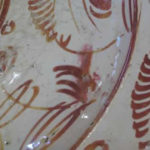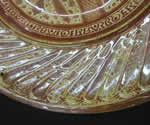For about two hundred years, from 1400 to 1600, lustreware was one of Spain’s most sought-after and exported luxury commodities. The economic success of this industry was due in large part to the continuous employment of Muslim potters even after the Reconquest in 1492. Muslims living in Spain under Christian rule were known as Mudéjars. They continued to work within the decorative traditions of Muslim Spain, and were responsible for the transmission of lustreware knowledge, as this highly specialised craft was learned through first-hand experience, and passed on from one generation of potters to the next.

The small town of Manises was for many years the most important centre in the region of Valencia; it had a thriving trade, and through its proximity to the international port of Barcelona, was able to export its wares all over Europe.
The production of lustreware was costly because it was technically very difficult to achieve and the ingredients were expensive, especially the silver for the lustre and the imported tin for the creamy white glaze. Although it was a luxury industry, many of the wares thought to have been made during the sixteenth century show firing accidents, smudges, fingerprints and distorted handles.
Other recurring imperfections, such as the misalignment of painted and moulded decoration in areas like the gadrooning around the dish, suggest the speed with which painters worked to meet orders. The presence of so many mistakes might also suggest that what mattered most to the international clients of Spanish lustreware was the overall effect of luxury achieved by the display of a huge quantity of wares, rather than the exquisite quality of individual pieces.
Spanish lustreware is extremely difficult to date because of the continuity of its designs. This continuity led to the invention of the term ‘Hispano-Moresque ware’ in the nineteenth century. This has recently been replaced by the more neutral ‘Spanish lustreware’, which describes it technically and situates it geographically, and at the same time distinguishes it from the earlier lustreware of Islamic Spain.
Italy was the most avid importer of Spanish lustreware. By the time this dish was made, potters from two Italian towns in Umbria, Gubbio and Deruta, had perfected their own version of lustreware, which imitated the look of Spanish lustre although the colours were quite different.
As interest in acquiring Italian lustred ceramics rose, Valencian lustreware became less desirable abroad and there was a sharp drop in exports. The region did however continue to produce its traditional lustreware, for a domestic market at least, well into the eighteenth century.
Back to Spanish Lustre Dish



